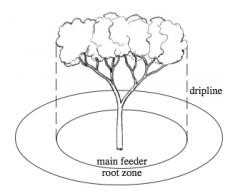Trees and shrubs often are forgotten when it comes time to fertilize the yard in the spring. Young trees, especially those with a trunk diameter of less than six inches, can benefit from regular applications of fertilizer. Older trees or those in lawns do not need as much fertilizer as younger trees.
 Tree root systems extend for a long distance and they absorb nutrients when the area around them is fertilized. Additionally, as trees mature, their roots develop associations with fungi called mycorrhizae. These beneficial fungi help the tree utilize minerals and elements in the soil.
Tree root systems extend for a long distance and they absorb nutrients when the area around them is fertilized. Additionally, as trees mature, their roots develop associations with fungi called mycorrhizae. These beneficial fungi help the tree utilize minerals and elements in the soil.
Before you fertilize, take a look at your trees and ask these questions to help you decide if your trees need additional nutrients:
• How much annual growth do you see? Most young trees average about 12 to 18 inches of new shoot growth each year; older trees have less.
• Is your tree growing less than expected?
• Has the color, size or amount of foliage changed over the past few years?
• Has the tree recently had disease or insect problems?
If you answered yes to any of these questions, the tree might benefit from fertilization.
On the coast, we like to fertilize three times a year. The first fertilizing is in late February, early March. The second is in late may before the spring rains stop, then fertilize again in late Fall. This is due to our sandy soils which do not hold the fertilizer in the soil.
Most woody plants begin the new year’s growth with elements stored from the year before. An application of fertilizer in the spring gives an additional boost to this new growth.
A general rule for fertilizing trees and shrubs – use 1/4 to 1/2 pound of nitrogen per inch of diameter for trees six inches or more in diameter. Use 1/4-pound actual nitrogen per inch on smaller trees. This is roughly two to four pounds of complete fertilizer per inch diameter on the larger trees and half that dosage on smaller trees. In most cases use the lesser amount.
Apply the fertilizer along the drip line of the tree, the area with the majority of the roots. If the fertilizer is applied to the soil surface only, much can be washed away or will not filter into the soil to the root zone.
Another way to fertilize is to “pepper” the ground with fertilizer as you walk around the drip-line of the tree. This method should also provide an adequate amount of fertilizer. Apply fertilizer in this manner right before it rains, so it will be washed into the root zone. Or water the fertilized area for an hour after application. Another way to determine fertilizer needs is to do a soil test. We recommend using a slow release fertilizer that allows the nitrogen to be released over time and is less likely to burn the roots.
